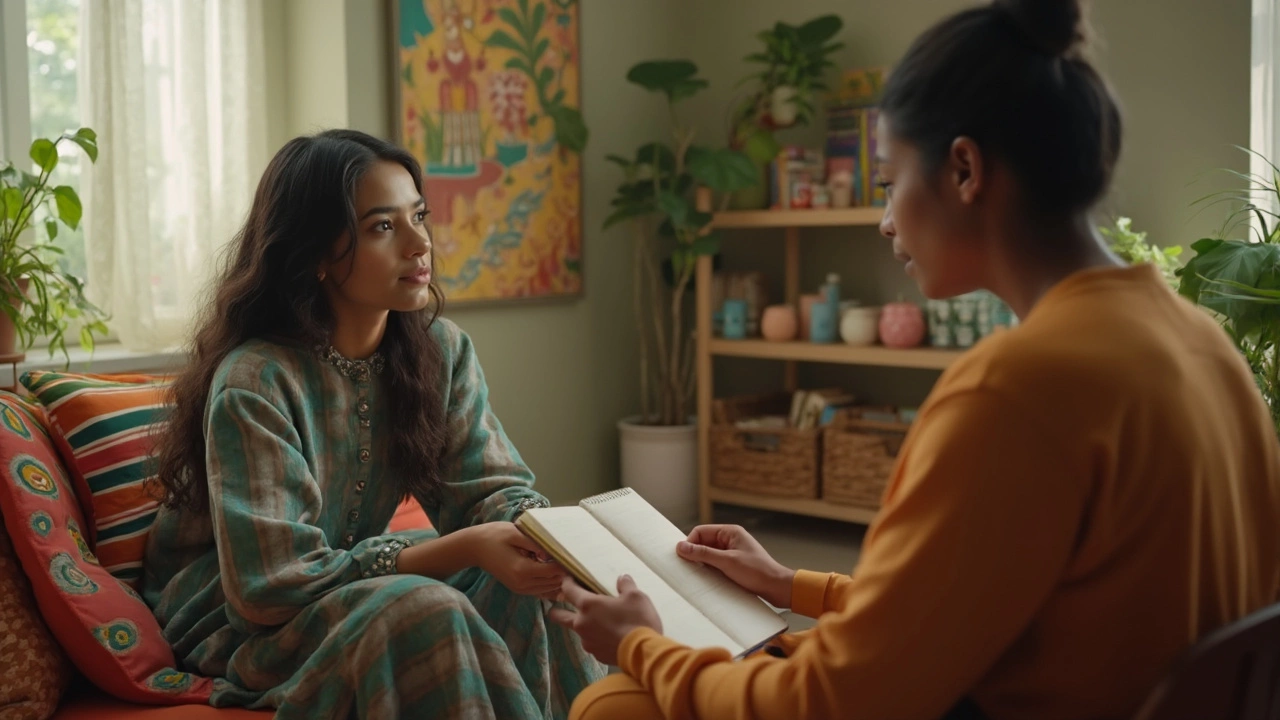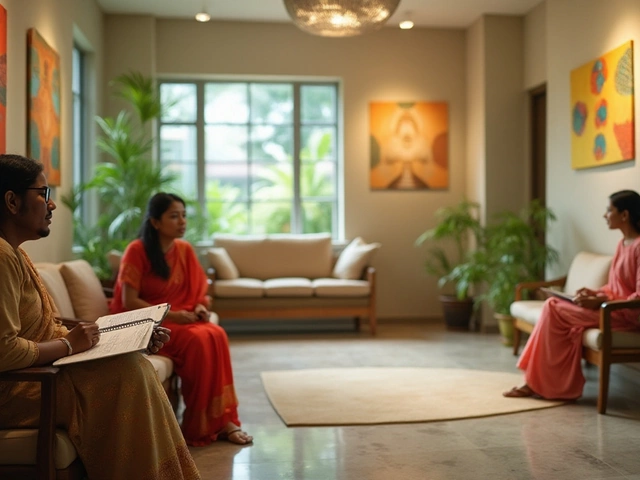
Ever wondered how many folks out there could really use therapy but never actually get it? It's a bit mind-boggling. For starters, imagine knowing a tool exists that can truly enhance your mental well-being, yet the majority miss out because of hurdles like stigma or costs. Sounds a tad frustrating, right?
Despite therapy becoming more talked about these days, many still shy away due to fears of being judged or simply because it feels like an expensive luxury. Not to mention, many just don’t know where to begin or think it’s only for those with severe issues.
But therapy isn’t just for emergencies or visible crises. Think of it as routine maintenance for the brain, much like a car service ensures smooth driving. Breaking down these barriers and changing how we view therapy is crucial.
- The Therapy Gap
- Barriers to Access
- The Stigma of Therapy
- Money Matters
- Raising Awareness
- Tips for Seeking Help
The Therapy Gap
We often hear how important mental health is, but the numbers tell a different story when it comes to actually getting help. A huge chunk of people who could really benefit from mental health therapy just don't get it. Estimates suggest that only about half of those with significant mental health conditions receive treatment. That's a pretty shocking statistic considering the importance of keeping our minds in check, just like we do for our bodies.
| Age Group | Percentage Receiving Therapy |
|---|---|
| Adults (18-64) | 43% |
| Adolescents (12-17) | 35% |
So, what's causing this gap? There are quite a few things at play. First off, stigma is still a biggie. A lot of people worry that seeking therapy makes them look weak or that others will judge them. And let's not forget the cost factor. Therapy can get expensive, and without insurance, it's often out of reach for many.
Another thing many people face is the sheer lack of awareness. Believe it or not, some just don't realize their struggles could be helped through therapy. It's not always about big breakdowns. Sometimes, it's just about needing a bit of support or a fresh perspective.
- Awareness: Educating people on recognizing mental health signs.
- Accessibility: Making therapy more affordable and available.
- Normalization: De-stigmatizing therapy talk in society.
Narrowing this therapy gap isn't going to happen overnight, but small steps, like increasing awareness and breaking down cost barriers, can make a difference.
Barriers to Access
When it comes to mental health, there's a surprising number of people who need therapy but just don't get it. Why? Because there are quite a few barriers standing in the way. First up, we've got the big one - the cost. Therapy can be expensive, and not everyone can afford it, even with insurance. For some, the price tag alone is enough to steer clear.
Then there's the ever-present issue of availability. In many areas, there just aren't enough mental health professionals to go around. This is particularly true in rural places where options are pretty limited. People might spend months on a waiting list before they can even talk to someone. Think about that for a moment, having to wait when you're ready for help is a massive roadblock.
Let's not forget cultural and language barriers either. For some folks, finding a therapist who understands their cultural background or speaks their language can be a challenge. This can lead to a lack of connection or understanding, making therapy less effective if it ever happens.
"Accessing mental health services is a challenge for many. We need a comprehensive approach to ensure everyone who needs help can receive it," says Dr. Jane Harmon, a renowned psychologist.
You'd think that awareness would be better in today's connected world, but surprisingly, many still don't know how therapy can help them or even where to start. They might not even realize that their struggles are worthy of professional help. Education around mental health is key here.
Here's a quick look at some stats that paint the picture:
| Barrier | Proportion Affected |
|---|---|
| Lack of Insurance | 25% |
| Cultural or Language Barriers | 15% |
| Stigma | 35% |
Addressing these barriers requires a real effort from policymakers, health providers, and communities to make mental health services more accessible and inclusive for everyone.
The Stigma of Therapy
Let's talk about something that's often whispered about—the stigma surrounding mental health therapy. It's surprising that, even today, many people shy away from therapy due to fear of judgment. It's like everyone wants to be seen as having it all together, even when that's far from the truth.
Why is this stigma still hanging around? A lot of it comes from misconceptions. Some folks think that seeking therapy is a sign of weakness or that it's only for people with severe mental illness. But that's like saying going to the gym is only for people with six-packs. Therapy is about taking care of your mental health, just like you'd take care of your physical health.
In some communities, there's pressure to handle issues on your own, which can lead to people avoiding therapy. But being tough isn't about denying help—it's about knowing when you need it.
Let's look at some numbers. Only about one-third of people with a diagnosable condition actually get help. That's millions out there not getting the care they might need because of how therapy is perceived.
So, what can we do? Start the conversation. Share personal experiences if you're comfortable. Normalize therapy by talking about it like you would any other health treatment. Like everything, change starts small, sometimes just with a chat among friends or family.

Money Matters
Alright, let's address the elephant in the room when it comes to mental health care: the cost. For many, this is the biggest roadblock. Therapy isn't cheap, and when you're juggling bills, the rent, and grocery shopping, setting aside money for therapy can feel impossible.
It's crazy to think, but even in our so-called modern world, a lot of health insurance plans still skimp on covering mental health therapy. Some plans limit the number of sessions or don't include sessions at all. And if you're looking at private therapy, well, the costs can soar, depending on where you live and the therapist's expertise.
For some real-world context, the average cost for a single session can range from $75 to $150 in many places. That's for just one hour! In bigger cities, it could even go up to $250. It's no wonder people hesitate to dive into therapy.
But hey, there's a silver lining. Options like sliding scale fees, community centers offering low-cost therapy, and online platforms have made therapy a bit more accessible. These online services are a game-changer, offering support at a fraction of the cost of traditional in-person sessions. Platforms like BetterHelp and Talkspace are making professional help more affordable and convenient. These aren't just gimmicks; they're real alternatives for folks who feel the pinch but need support.
Plus, if you're a student, many universities offer free counseling services. It's worth checking if your institution has something you can tap into. Remember, the goal is to find something that works for your financial situation while still providing good support.
Raising Awareness
So, let's talk about raising awareness for something as crucial as mental health therapy. It's no rocket science that more people need therapy than those who actually go for it. One of the key ways to bridge this gap is through spreading the word far and wide.
First off, schools can be a starting point. Imagine if mental health education was a standard part of the curriculum. It would equip kids with the knowledge they need early on, making the idea of seeking mental health support as normal as hitting the gym.
Community events can also play a big role. Consider health fairs or local talks where professionals discuss the benefits and perceptions of therapy. This can help crush the stigma around it and encourage more people to open up about their own struggles. Organizations can partner with local therapists to offer workshops or free initial consultations, making therapy feel more accessible.
Social media is another giant. With platforms like Instagram and TikTok, information can go viral quickly. Think about campaigns or challenges that encourage people to share their therapy experiences. When influencers and regular folks alike normalize therapy, it becomes a less daunting option for many.
Here's a little table to add a stat punch:
| Year | Percentage Aware |
|---|---|
| 2020 | 45% |
| 2023 | 55% |
This simple awareness increase shows that more people are getting clued up, but there's still work to be done.
Ultimately, making therapy a mainstream topic of conversation in society can break down barriers and make it feel like the most natural, beneficial choice for so many who currently miss out.
Tips for Seeking Help
Alright, so you're thinking about getting some mental health therapy but not quite sure where to start? No worries, we've got some solid steps here to help you kick things off smoothly.
First off, it's important to know that you're not alone. According to the National Institute of Mental Health, nearly one in five adults lives with a mental health condition. Seeking help isn't a sign of weakness—it's a step towards better mental well-being.
As Dr. Sarah Johnson, a renowned psychologist, once said, "Reaching out for therapy can open doors to understanding yourself and changing your life for the better."
So, how do you actually go about getting the help you need? Here are some practical steps:
- Identify Your Needs: Are you dealing with stress, anxiety, or something specific? Knowing what you need can guide your choice of therapy.
- Research Therapists: Look for therapists who specialize in what you're experiencing. Check online reviews and their qualifications.
- Check Accessibility: Consider factors like location, office hours, and whether they offer virtual sessions if that's your preference.
- Understand Costs: Therapy can be pricey, so check if your insurance covers it or if the therapist offers sliding scale fees. Don't hesitate to ask directly about costs.
- Schedule a Consultation: Many therapists offer a free initial consultation. This can help you see if they're a good fit.
- Prepare for Your First Session: Jot down what you want to discuss or any questions you have. Being prepared can help make that first session less daunting.
Remember, finding the right therapist might take a bit of trial and error. It's like finding a pair of shoes that fit just right—sometimes you have to try on a few.
Whatever you do, don't give up on finding the right support. Therapy can be a crucial part of enhancing your mental health and ultimately lead to a happier life.







